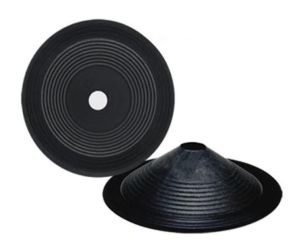Cone paper

Cone paper, often referred to as the speaker cone, is an essential component in the design and functionality of loudspeakers. It plays a critical role in the conversion of electrical signals into sound waves. Here’s an in-depth look at cone paper used in speakers:
Material and Composition
- Paper: Traditional speaker cones are made from paper pulp, which is often treated to enhance durability and acoustic properties. This treatment can include additives like resins or coatings to improve strength and reduce moisture absorption.
- Blended Materials: Some modern cones use a blend of paper with other materials like carbon fiber, Kevlar, or glass fibers to enhance performance. These composite cones aim to combine the natural acoustic properties of paper with the strength and rigidity of synthetic materials.
Design and Function
- Shape: The cone shape is crucial for directing sound waves and ensuring efficient movement. The wide base of the cone attaches to the speaker’s surround, while the narrow end connects to the voice coil.
- Flexibility: Paper cones are valued for their balance between rigidity and flexibility. This balance allows them to move accurately in response to the audio signal, producing clear and precise sound.
- Damping: The inherent damping properties of paper help to reduce unwanted resonances and distortions, contributing to a smoother frequency response.
Advantages of Paper Cones
- Natural Sound: Paper cones are known for their warm and natural sound reproduction, particularly effective in the mid-range frequencies. This makes them popular in hi-fi and audiophile speakers.
- Lightweight: Paper is a lightweight material, which allows for fast and responsive movement. This responsiveness is crucial for accurate sound reproduction.
- Cost-Effective: Manufacturing paper cones is generally less expensive than producing cones from advanced materials like carbon fiber or Kevlar.
Disadvantages of Paper Cones
- Moisture Sensitivity: Paper can absorb moisture from the air, which may affect its acoustic properties and durability over time. Treated paper cones can mitigate this issue, but it remains a concern in humid environments.
- Structural Weakness: Compared to some modern materials, paper cones may lack the same level of strength and rigidity, making them more susceptible to damage under extreme conditions.
Applications in Different Types of Speakers
- Home Audio Systems: Paper cones are commonly used in home audio speakers due to their warm sound and cost-effectiveness.
- Car Audio Systems: Many car speakers also use paper cones, benefiting from their natural sound and lightweight properties.
- Professional Audio Equipment: While some high-end professional speakers may use advanced materials, paper cones are still found in many applications due to their balanced performance.
Maintenance and Care
- Avoid Moisture: Keeping paper cone speakers in dry environments helps to maintain their performance and longevity.
- Clean Carefully: Dust and debris can be gently removed with a soft brush or compressed air to prevent damage to the cone surface.
- Check for Damage: Regularly inspect the cones for signs of wear or damage, such as tears or deformities, which could affect sound quality.
Innovations and Future Trends
- Hybrid Cones: Ongoing research and development in speaker technology are leading to the creation of hybrid cones that combine paper with other advanced materials. These hybrids aim to leverage the acoustic benefits of paper while enhancing durability and performance.
- Eco-Friendly Materials: With increasing environmental awareness, some manufacturers are exploring sustainable and eco-friendly materials for speaker cones, including recycled paper and natural fibers.
In summary, cone paper remains a pivotal element in the design of speakers, cherished for its natural sound quality and cost-efficiency. Despite some limitations, ongoing innovations continue to enhance its performance, ensuring its place in the audio industry for years to come.